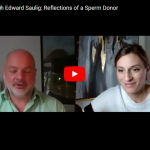 By Jennifer Lahl, CBC National Director
By Jennifer Lahl, CBC National Director
Louise Brown was born in the United Kingdom on July 25, 1978, the world’s first test-tube baby, conceived by in vitro fertilization (IVF).
Just five years later in Australia, fertility doctors used the first donor egg in an IVF procedure. Since then, IVF technologies have been accepted almost entirely without criticism as the treatment of choice for couples struggling with infertility. These technologies have become so mainstream that we now see IVF treatments being used by couples with otherwise healthy and functioning reproductive bodies.
Same-sex couples can now become parents using donated eggs, sperm, and surrogate wombs. To be a “single mom by choice” is gaining popularity as a lifestyle option for women who don’t want to wait for Mr. Right—or who just choose, as “Octumom” did, not to bother with Mr. Right.
Post-menopausal women, sometimes well into their 60s, who should be welcoming grandchildren into their families, are seeking reproductive technologies for more children of their own.
Recently, Illinois passed a new law requiring insurance providers with IVF coverage to extend benefits not just to infertile couples, but now to same-sex couples and single-by-choice folks (neither of whom can be said to be “infertile” in any common sense).
The baby-making industry is now a global market, making many rich as others are being exploited. Furthermore, reproductive technologies are becoming increasingly eugenic, seeking to design the “best” children money and technology can buy.
Egg Donation
Take a look at the egg donation market in the U.S. The most recent data from the Centers for Disease Control and Prevention states that in 2007, in the United States alone, over 17,000 assisted reproductive technology cycles were performed using donated eggs. And this number is on the rise.
The majority of cycles were performed using anonymously donated eggs, meaning the young egg donor has no idea if her eggs produced children and who the parents are. Would-be parents scour the internet and egg broker agencies like “Our Fairy Godmother,” or “A Perfect Match,” looking for the best genetic material available to create a child of their dreams.
Certain desirable characteristics—being pretty or tall or having high SAT scores—can fetch more money for the donor. If the donor’s eggs produce healthy children, she has secured her position as the coveted proven egg donor who can donate again and again, often at even higher payments.
But the general public, let alone most potential egg donors, doesn’t really understand (1) what is involved in egg donation—that is, how doctors can manipulate a young woman’s body to produce multiple eggs at one time (Hint: It requires many weeks of injecting powerful hormones, followed by anesthesia and surgery to remove the eggs), and (2) how little we have studied the effects of the donation procedures on egg donors over time—we have little to no data on the short- and longer-term risks to egg donors who take the powerful drugs needed to produce many eggs.
For those who ascribe to the Christian view of marriage, family, and procreation, certainly we can agree that third-party means to build a family are quite problematic. And we should be deeply concerned about the potential harm done to young women.
Market Competition
But as the egg donation practice continues, now the competition is expanding. Human eggs are a coveted resource for embryonic stem cell and cloning researchers. On June 14, the California Institute for Regenerative Medicine—responsible for spending CA Proposition 71’s $3 billion in taxpayer funds on human embryonic stem cell and cloning research—had a private session where the agenda was to discuss “Procurement of Human Oocytes [eggs].”
Two of my colleagues attended this meeting, but were barred from entering. They were told the meeting was private because of the need to protect intellectual property. One has to wonder what intellectual property needs to be protected when the discussion is around the purchasing of human eggs for research, which is prohibited in California.
Currently, the only state that can pay donors for their eggs for scientific research is New York, and that is now being challenged in the courts. Of course, California stem cell researchers are trying to change that law. They argue that since we can pay egg donors to sell their eggs to the IVF industry, they should also be able to compete for human eggs, since they assert their research will ultimately benefit sick people.
Caught in the Middle: The Eggsploited
Our new documentary film, Eggsploitation, seeks to spotlight the booming business of human eggs, told through the tragic and revealing stories  of real women who became involved and whose lives have changed forever. You will meet women whose stories you won’t hear in the mainstream press, and aren’t talked about on Oprah or discussed at professional meetings among fertility specialists. Some are women who were students on prestigious college campuses in America, racking up student loan debt, who responded to ads posted in their school newspapers and on bulletin boards, and thought the answer to their mounting debt was to answer an ad to “help make someone’s dream come true.”
of real women who became involved and whose lives have changed forever. You will meet women whose stories you won’t hear in the mainstream press, and aren’t talked about on Oprah or discussed at professional meetings among fertility specialists. Some are women who were students on prestigious college campuses in America, racking up student loan debt, who responded to ads posted in their school newspapers and on bulletin boards, and thought the answer to their mounting debt was to answer an ad to “help make someone’s dream come true.”
This film seeks to shed light on the experiences of these young women, telling the full story of this multi-billion dollar industry. As one young woman laments in a comment shared with her mother, after her near brush with death, “The industry knew that this would happen sooner or later. They’ve just been rolling the dice and it fell on your daughter. It was worth the money to them.”
This article originally appeared on BreakPoint.
Author Profile
Latest entries
 Sperm DonationMarch 15, 2022Venus Rising with Edward Saulig: Reflections of a Sperm Donor
Sperm DonationMarch 15, 2022Venus Rising with Edward Saulig: Reflections of a Sperm Donor BioethicsMarch 13, 2022Dr. C. Ben Mitchell: 2022 Ramsey Award Winner
BioethicsMarch 13, 2022Dr. C. Ben Mitchell: 2022 Ramsey Award Winner #BigFertilityMarch 10, 2022Documentary Explores One Woman’s Journey through Egg Donation
#BigFertilityMarch 10, 2022Documentary Explores One Woman’s Journey through Egg Donation BioethicsMarch 9, 2022Questioning the “Science” of the Gender Industry
BioethicsMarch 9, 2022Questioning the “Science” of the Gender Industry

